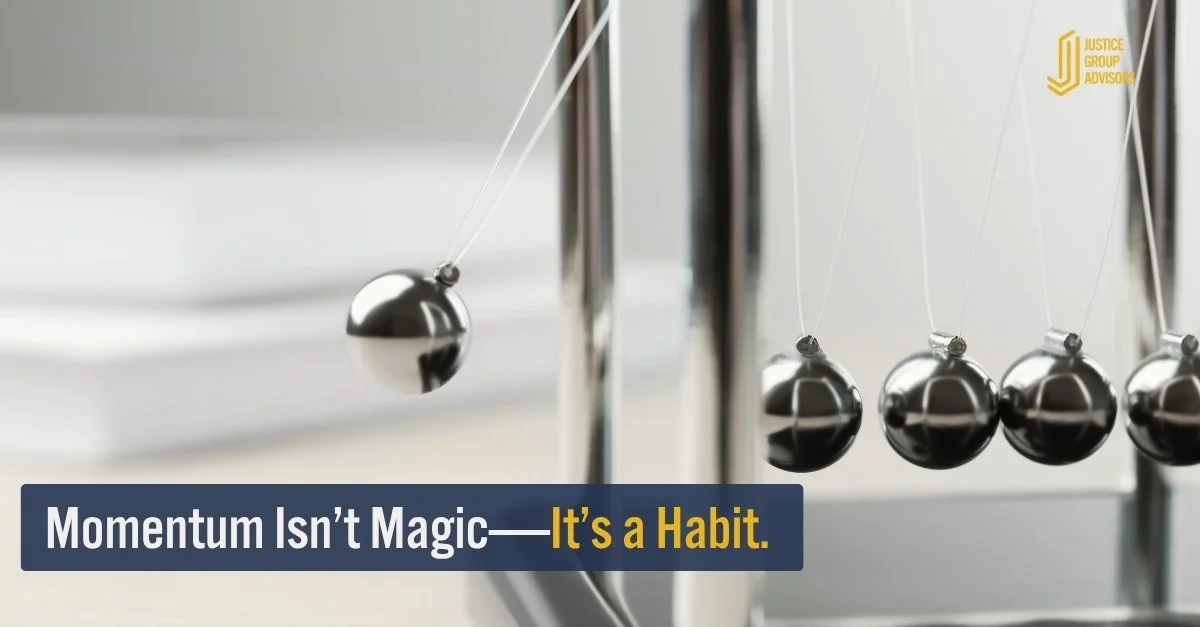Momentum Isn’t Magic—It’s a Muscle. Here’s How to Build It.
Practical strategies for turning progress into performance.
You hit the milestone.
You take a breath.
Maybe even celebrate it—briefly.
And then… you’re right back at it. New goals. New pressure. New expectations.
If that sounds familiar, you’re not alone.
Most high-performing leaders know how to get things done. What’s harder is building the kind of sustainable leadership momentum that makes success feel steady—not like a sprint you’re barely keeping up with.
But here’s the good news:
Momentum isn’t magic. It’s a muscle. And like any muscle, it can be built—intentionally.
Let’s talk about how.
Why Momentum Feels Elusive
Even when we accomplish something meaningful, it’s easy to move on too fast. That’s not a character flaw—it’s biology.
Negativity bias makes our brains naturally prioritize what’s wrong over what’s right.
Hedonic adaptation is the brain’s version of a hamster wheel—what once felt like a major win quickly becomes the new normal.
And the productivity trap convinces us that pausing means falling behind.
So we skip the reflection. We skip the reinforcement.
We skip the very steps that build momentum—and wonder why it feels so hard to sustain.
(Related: Why Celebrating Wins Matters More Than You Think)
What Momentum Really Takes
If you want to lead with clarity, confidence, and consistency—not just urgency—you need a system for reinforcing what works.
That’s where the Momentum Loop comes in.
The Momentum Loop
Think of this as your new leadership development habit loop. It’s simple, science-backed, and completely doable.
1. Celebrate the Win
Even a small one. This isn’t indulgent—it’s reinforcement.
Each time you pause to acknowledge success, you activate dopamine pathways that reward the behavior and increase motivation.
Harvard Business School professor Teresa Amabile, author of The Progress Principle, found that even small wins are a powerful source of workplace motivation and sustained engagement.
This isn’t about team parties or gold stars.
It’s about saying—this mattered.
2. Reflect on What Worked
Ask yourself: What created this success?
Was it a mindset shift? A better process? Saying no to something?
This step turns dopamine into insight. It encodes the learning—and helps you repeat it.
🧠 Hebbian theory says: neurons that fire together wire together. When you pair reflection with reward, you strengthen the neural pathway that made the win possible.
3. Translate Insight Into Action
Now make it repeatable.
How will you build on this? What habits or leadership strategies can you carry forward?
Momentum isn’t just about progress—it’s about pattern recognition.
This is how you shift from “I got lucky” to “I know how to do this again.”
4. Signal It—To Yourself and Others
This is where leaders often stop short.
But when you name the progress out loud—to a mentor, a peer, a team—it does two things:
It builds trust (people see your clarity and consistency).
It spreads energy (momentum is contagious).
Even a quick Slack message or comment in a meeting like “here’s something that worked well this week” can model what sustainable leadership looks like—and encourage others to notice their own wins.
Why This Works (Especially for Leaders)
The best leaders don’t just create momentum—they model it.
When you reflect on progress and make it visible, your team learns that growth isn’t accidental. It’s intentional. It’s learnable. It’s part of the culture.
And when things get tough (because they always do), you’ll have a track record of small wins and strategic insights to draw from—not just pressure to keep performing.
Try This
Before this week ends, ask yourself:
What’s one thing I’m proud of?
What helped me make that happen?
How can I build on it?
Who needs to hear about it?
Write it down. Say it out loud. Let it sink in.
That’s how momentum starts—not with a lightning bolt of inspiration, but with a single moment of intentional reflection.
The Bottom Line
You don’t need to work harder.
You need to notice more.
Momentum isn’t about hustle—it’s about reinforcement.
And the leaders who know how to build it?
They’re the ones who rise faster, last longer, and bring others with them.
What’s one win you can build on this week?


